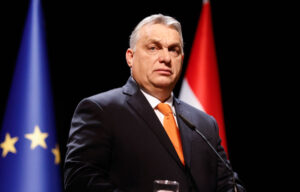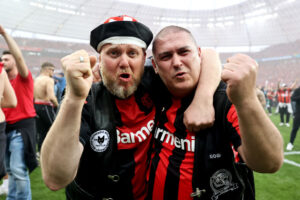The first time I interviewed a president of Ferencváros, Hungary’s most successful football club, the taxi driver who picked me up from the stadium asked if I was a new signing. Nothing, perhaps, could have been more revealing of the state of Hungarian football. It was nearly 20 years ago, but, even so, none of Europe’s elite sides was signing scrawny bespectacled men carrying laptops. Nobody would make that mistake these days: Ferencváros are a modern, thrusting club and their ramshackle home on Üllői út has been transformed into the gleaming Groupama Arena.
Once, the rich and powerful built cathedrals or temples; now they build stadiums. The Olimpico in Rome was Mussolini’s reimagining of an amphitheatre, positioning himself as emperor. The concrete sweep of the Maracanã in Rio de Janeiro was modernism tempered by a Latin sensuality entirely in keeping with the optimistic Brazil of the late Forties. Al-Bayt, a tent emerging from the desert north of Doha, was a vast symbol of Qatar’s welcome to the world. The Groupama Arena, you suspect, is how Viktor Orbán’s Hungary likes to see itself: energetic, modern and yet rooted in history; before the main entrance are three statues, of the former players Sándor Kocsis and Flórián Albert, and of the first chairman of Ferencváros, Ferenc Springer.
As thousands mustered in support for him at the weekend, few would argue that Orbán’s rule has been illiberal, but his achievements, at best, have been mixed. Where he has unquestionably succeeded, however, is in football. Why does it occupy so much of his energy?
Sport lies at the heart of Orbán’s project and football is his greatest love: the Groupama Arena is one of more than 40 football stadiums refurbished since he returned to power in 2010. Orbán used to play for the youth team of Videoton, a club based in Székesfehérvár near his home village of Felcsút, while his first official overseas trip in his first stint as prime minister was to the 1998 World Cup final. In 2007, when he was out of office, he founded a football academy in Felcsút, naming it after Puskás, Hungary’s greatest ever player. Six years later, the academy team was promoted to the top flight for the first time and has since qualified for Europe three times.
This was, of course, something of a political victory, too. All 12 sides in the Nemzeti Bajnokság have some sort of link to Fidész, the governing party, though none more overt than Ferencváros, who in April sealed their fifth Hungarian league title in a row. Their president since 2011 has been Gábor Kubatov, an MP and vice-president of Fidész. When we met last month, I wondered how willing he would be to get into the politics of it all — but within seconds, the familiar Fidész lines were spilling out. “We are a Christian country 1,000 years old,” he said. “We protect our heritage and history. We look after our culture and beliefs. We stopped migration at the border and we don’t allow gender ideology. As a result, Hungary has become the most secure country in Europe. You can walk safely at night in Hungarian cities.”
As for so many in Fidész, for Kubatov 2010 — the year of Orbán’s return — marks year zero. Everything is before or after that date. And for football, the picture has transformed radically for the better. It’s not just the tax breaks that have allowed the rash of new and refurbished stadiums. Before 2010, grassroots clubs were disappearing; often poorly maintained, few protested when their pitches were built over. Since 2010, however, resources have been found to build 1,590 new pitches and refurbish 2,800 others.
But why? György Szöllősi, the editor of the national sports daily Nemzety Sport, and a former head of media at the Puskás Academy, often talks of the need to reverse the underinvestment of the immediate post-communist years — but there are other more obviously important demands on the public purse, notably health and education.
Tracing the results of investment in football infrastructure is never straightforward, but there are worse places to start than 2016, when Hungary qualified for the European Championship, their first appearance at a major finals since 1986. Although they’ve missed out on both World Cups since, they also qualified for both Euro 2020 and 2024 and will play in the highest tier of the 2024-25 Nations League, having twice beaten England in the last edition. And, for the first time in a long time, there is a clutch of Hungarian players at top European clubs — notably Dominik Szoboszlai at Liverpool and Péter Gulácsi and Willi Orbán (no relation) at RB Leipzig. Progress for club sides has been less striking but since 2010, the Hungarian league has risen from 32nd in the Uefa ranking of coefficients to 23rd.
The other big change in football since 2010 has been the crowds, which are slowly growing again. Last season, the average attendance was 3,541. That’s still well down on the mid-Fifties when 15,000 or so was standard — but, excluding the Covid lockdown, the average has risen every year since 2015, when they hit a low of 2,502.
The make-up of crowds is changing as well. Kubatov remembers with shame the monkey-chanting that greeted the visit of Ajax to Ferencváros in 1995, or the way ultras would habitually mark Hitler’s birthday with antisemitic songs and gestures. He has attempted to tackle that in his time as president, with the result that ultras boycotted Ferencváros games for three and a half years. Lighting flares and invading the pitch have been criminalised, while improved security at games, with cameras and tickets that carry biometric data, means that perpetrators can be isolated and prosecuted. “When they’ve been fined 2 million Forints (£4,400),” Kubatov said with a slightly alarming relish, “they’ll think twice about it.”
Which all sounds very much in line with Fidész’s tough stance on law and order, but it doesn’t tally with memories of the last Euros, when black-clad Hungary fans directed monkey chants at France’s players and brandished homophobic banners. Jude Bellingham and Raheem Sterling were also racially abused during a World Cup qualifier in Budapest in 2021. And when England last played in Hungary, in the Nations League a year later, it was in a stadium from which adult fans had been banned because of racist and homophobic chanting. “The committee that makes a decision like that,” Hungary’s foreign minister Peter Szijjarto said, “is a pitiful and cowardly body. They should be ashamed of themselves.”
Those black-clad fans are the Carpathian Brigade, the result of a Fidész policy that seems to have backfired. In 2009, party leaders met ultra groups from various clubs and, in an attempt to curtail neo-Nazi violence, formed the Brigade. Initially, it was supposed to bring fans together behind the national team while helping various charities. For a while it worked, but as the Brigade grew in popularity, the far-Right element took control and there was violence at games against Romania in 2013 and 2014. Which presents Fidész with a problem. On the one hand, the ultras are on their side on most culture-war issues — but on the other, they have the potential to be an embarrassment while at the same time representing a dangerously anarchic force.
Since the Fifties, football terraces have been a locus of dissent, the weight of numbers providing a measure of security, which perhaps explains why Kubatov is so keen to crack down on misbehaviour. But hooliganism also puts off the families and wealthier fans he wants to attract for business reasons; he has even discussed a fast-track system for stadium entrance for those willing to pay for it. But football, as many illiberal regimes have found, is not readily controllable; club affiliation offers an identity that can challenge the regime.
This makes Orbán’s obsession fascinating. It’s not as simple as bread and circuses; even if the trend is upward, attendances at Hungarian league games are simply not big enough for anyone to think they serve as a mass distraction or opiate. Rather, there is clearly a sense that, by staging major events, Hungary, in a less dramatic way than Saudi Arabia or Qatar, is positioning itself as a major player in global sport with all the attendant benefits that brings in terms of influence and prestige. Budapest’s vast Puskás Arena, it was announced in April, will host the 2026 Champions League final.
Orbán himself overtly harks back to the early Fifties when Hungary was widely regarded as the best side in the world, as though trying to portray the present as the start of a second golden age. The problem with that, though, is both a sense of Puskás-fatigue and the fact that, while the early Fifties might have been a great era for Hungarian football, the economy was collapsing and a backlash was beginning against Mátyás Rákosi’s hardline Stalinist regime, leading ultimately to the 1956 uprising and the mass defection of players, including Puskás — something of which Orbán must be aware.
Orbán, a keen reference of the importance of 1956, no doubt knows this. In the end, his investment in football may come down to nothing more complicated than the fact that he really likes football.
Disclaimer
Some of the posts we share are controversial and we do not necessarily agree with them in the whole extend. Sometimes we agree with the content or part of it but we do not agree with the narration or language. Nevertheless we find them somehow interesting, valuable and/or informative or we share them, because we strongly believe in freedom of speech, free press and journalism. We strongly encourage you to have a critical approach to all the content, do your own research and analysis to build your own opinion.
We would be glad to have your feedback.
Source: UnHerd Read the original article here: https://unherd.com/



